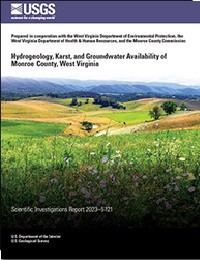
Product Details
- Product Number
- 534246
- Series
- SIR-2021-5078-C
- Scale
- NO SCALE
- Alternate ID
- SIR-2021-5078-C
- Authors
- BY: ALEXIS CLARK
- Version Date
- 01/01/2021
- Countries
- USA
- Media
- Paper
- Format
- Bound
Additional Details
- Description
-
Groundwater Budgets for the Big Lost River Basin, South-Central Idaho, 2000–19
Scientific Investigations Report 2021-5078-C
Prepared in cooperation with the Idaho Department of Water Resources
By: Alexis Clark
Edited by: Lauren M. Zinsser
https://doi.org/10.3133/sir20215078C
First posted November 9, 2022
For additional information, contact:
Director , Idaho Water Science Center
https://www.usgs.gov/centers/idaho-water-science-center
U.S. Geological Survey
230 Collins Road
Boise, Idaho 83702-4520
Abstract
The Big Lost River Basin, located in parts of Butte and Custer Counties in south-central Idaho, supports the communities surrounding the cities of Arco, Leslie, Mackay, and Moore and provides for agricultural resources that depend on a sustainable supply of surface water from the Big Lost River and its tributaries and groundwater from an unconfined aquifer. The aquifer, situated in a structurally controlled intermontane valley, is composed of unconsolidated alluvium, consolidated sedimentary and volcanic rocks, and younger interbedded volcanic rocks.
This report presents two separate groundwater budgets for the aquifer, one above and one below Mackay Dam, as well as a combined groundwater budget for the aquifer within the entire Big Lost River Basin. The budgets span a 20-year period (2000–19), characterizing average conditions, a dry year (2014), and a wet year (2017). The groundwater budgets will help address questions regarding the availability of groundwater supply in the Big Lost River Basin and inform future groundwater modeling. The Idaho Geological Survey has prepared the groundwater budgets as part of a larger hydrogeologic investigation completed by the U.S. Geological Survey and the Idaho Geological Survey in cooperation with the Idaho Department of Water Resources during 2018–21. Other reports describe the hydrogeologic framework and several streamflow-measurement events to evaluate gains and losses on the Big Lost River. Collectively, these reports provide an updated characterization of groundwater resources in the Big Lost River Basin which will help address water resources challenges.
A groundwater budget is a conceptual and numerical accounting of inflow (recharge) to groundwater and outflow (discharge) from groundwater. The predominant sources of recharge to the aquifer include losing river reaches (33 percent), areal recharge (as precipitation less evapotranspiration and surface runoff, comprising about 23 percent of the total inflow), tributary canyon underflow from higher altitudes (20 percent), canal seepage (13 percent), recharge through applied irrigation on fields below the root zone and other minor sources (11 percent), and Mackay Reservoir seepage (less than 1 percent). The primary sources of discharge from the aquifer are groundwater pumpage to meet irrigation demand, domestic supply, and municipal supply (76 percent) and gaining river reaches (24 percent).
The positive or negative difference between the sum of all inflows and outflows is regarded as the residual, representing the change in groundwater storage, groundwater outflow from the basin or subbasins, and uncertainty and errors in the budget. In the Big Lost River Basin, groundwater outflow is at the mouth of the basin below Arco into the eastern Snake River Plain aquifer.
The total mean annual estimated recharge to the Big Lost River Basin was 439,100 acre-feet per year (acre-ft/yr; 607 cubic feet per second [ft3/s]) for 2000–19, 373,900 acre-ft/yr (516 ft3/s) in 2014, and 762 ,100 acre-ft/yr (1,053 ft3/s) in 2017. The mean annual estimated groundwater discharge from the aquifer was about 112,300 acre-ft/yr (155 ft3/s) for 2000–19, 153,500 acre-ft/yr (212 ft3/s) in 2014, and 53,400 acre-ft/yr (74 ft3/s) in 2017. The estimated mean annual groundwater residual was 326,800 acre-ft/yr (451 ft3/s) for 2000–19, 220,400 acre-ft/yr (304 ft3/s) in 2014, and 708,700 acre-ft/yr (979 ft3/s) in 2017. The mean annual residual above Mackay Dam was 100,400 acre-ft/yr (2000-19), 96,700 acre-ft (2014), and 248,300 acre-ft (2017). The mean annual residual contribution below Mackay Dam, minus any groundwater-flow above Mackay Dam, was 226,400 acre-ft/yr (2000-19), 123 ,700 acre-ft (2014), and 460,400 acre-ft (2017).
These results are highly sensitive to assumptions about certain budget inflow parameters. In particular, the magnitude of the budget residuals during especially dry and wet periods is amplified by the groundwater-budget terms tributary streamflow and tributary underflow that contribute appreciable recharge but also have high uncertainty.
The results of the groundwater-budget evaluation describe an interconnected and complex hydrologic response throughout the basin to various climatic and water-use trends. The part of the basin above Mackay Dam typically has a positive groundwater residual derived from snowmelt recharge to tributary canyons and areal recharge in excess of groundwater pumpage for irrigation demand. This supply is used to meet irrigation demand above Mackay Dam and to provide for water supply below Mackay Dam. On average, groundwater inflow from above Mackay Dam to below Mackay Dam, assuming negligible reservoir storage effects, accounts for about 25 percent of the total groundwater recharge below Mackay Dam. Considerable recharge to groundwater below Mackay Dam occurs through seepage from the Big Lost River and canals and ditches. Most groundwater discharge from the aquifer is through irrigation pumping. The water supply below Mackay Dam is highly dependent on available upstream surface-water flows, the magnitude of the groundwater residual from above Mackay Dam, and annual variability in local groundwater conditions.
- Print Date
- 2021
- Height In Inches
- 11.000
- Length In Inches
- 8.500
- Two Sided
- Yes
- Pieces
- 1
- Languages
- English





